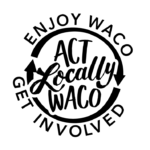By Liz Ligawa
Waco has been my home for a while now, but I am still learning how much there is to this beloved city. For instance, did you know that there are an estimated 700 non-profit organizations in Waco? I know- that’s a lot, but it’s not necessarily a bad thing. With the existence of so many non-profits, I don’t question that Waco is a community that cares. It shows me that there are many people and organizations working to make the lives of Wacoans better. However, I am curious about a few things. And as a result of my curiosities, I approached my work toward improving the lives Wacoans differently, and would like to share a few lessons I have learned along the way from the “What’s Up, Waco?” community visioning series.
Lesson 1: Ask powerful questions.
I have just reached my one year anniversary with Prosper Waco, and as the collective work of community change has continued, I have often been asked about the community’s priorities around this work. What I quickly learned is that many of us in the non-profit world were interested in an answer to a question that we were not really asking. So this year, the Prosper Waco Community Engagement Council and I focused on bringing forward community priorities through a three-series long conversation: “What’s Up, Waco?”
If you were to walk in on one of these events, you might mistake the DJ’s tunes, the green leis, and the hopeful atmosphere to be someone’s family reunion you stumbled upon. That would be a fair assumption, but don’t overlook what is really going on– the hard work of casting a vision and building a team around that vision.
The question that started the conversation was, “What are the results you want to see?” It may not seem like a powerful question, but it is not a question we frequently ask. Whether we are working with individuals, groups, or communities, I’ve learned that it is always appropriate to ask. The charts below map out where each community has decided to focus their work:
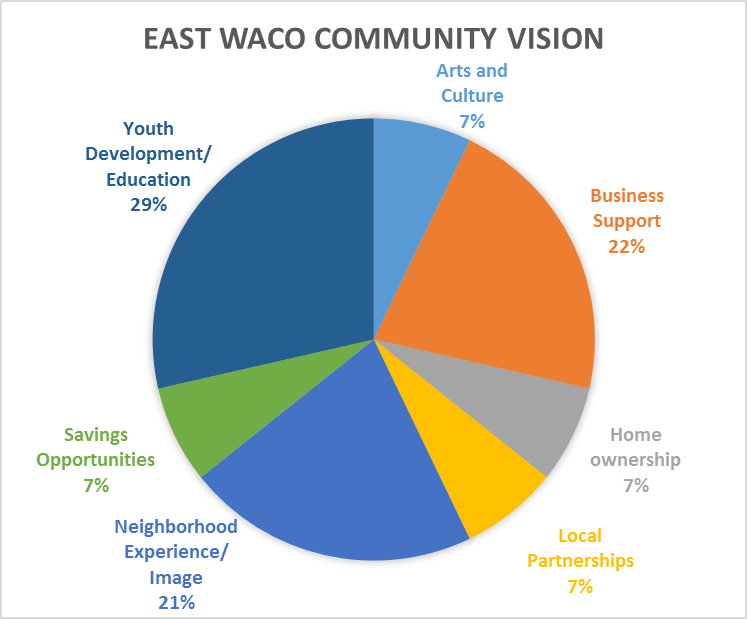
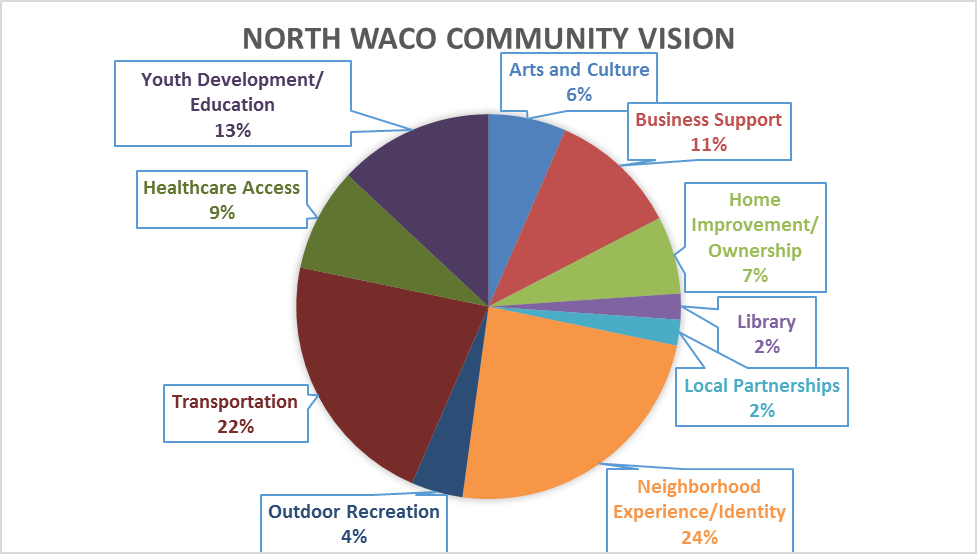
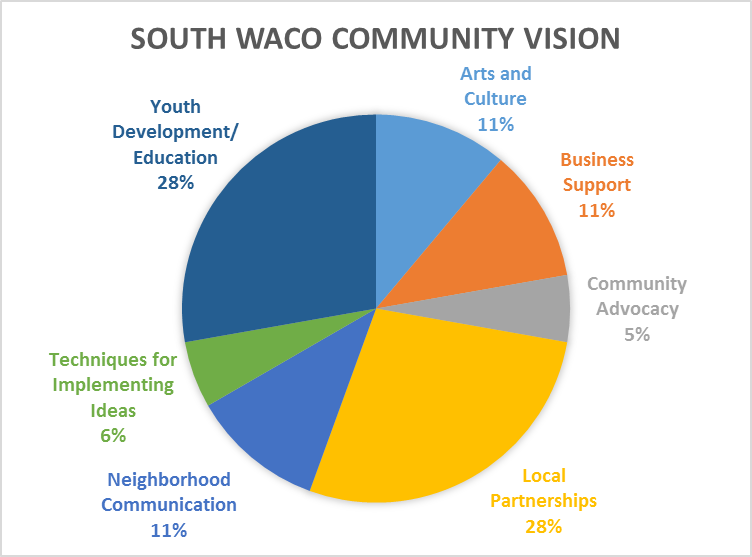
Lesson 2: Pity doesn’t help us listen- Empathy does.
In the field of non-profit work, and other helping professions, we find ourselves in a bit of a quandary sometimes. We are drawn to this work because of the change we want to see in the world, but often our desire to see change in the lives of people and communities paints a certain picture in our minds about people. We tend to see people through what data says about them, or their community. We receive messages about people as we look solely at the schools in their communities. We subscribe to narratives about people without even having to think about it. Messages are constant. Messages contribute to our understanding of people. Messages can be completely wrong. Try Googling the word “pregnant” and look at the images that come up. Now, put the word “poverty” in front of the word “pregnant” and hit search. Look at the images. Do you notice a difference?
I work with people in communities who bear heavy burdens of the stories that precede them before they even have a chance of showing up. Stories that are heavily influenced by an outsider’s perspective. Stories which play a role in every interaction. What learning has been affirmed for me in this series is that if I want to work with people, it is my responsibility to continually work at checking my biases and my pity (of whatever nature) at the door. To commit to the hard work of listening to truth, I must listen with empathy and not pity. When we engage people with pity, we run the risk of not affirming the agency of that person to contribute toward their own solutions for change. When we lead with empathy, we open ourselves up to learn.
Lesson 3: People are amazing- We need to level up!
When I decided that my own answers to other people’s problems would not create the change I hope to see in our community, I was afforded the opportunity to learn a lot more about the historical narratives and processes of change each community has been through. As they reflected on the history of their community, and started putting together strategies toward their vision, I learned how powerful truth is in the work of restoring our communities, and how important it is for that truth to be heard. In fact, 98% of more than 100 participants that have participated in the visioning so far responded “Agree” or “Strongly Agree” to the survey items: “I feel like my voice was heard”, and “This information was helpful to me, and/or my organization”. So, this last lesson is about my part, our part, in coming together. I leveled up by becoming proximate to the beautiful people and communities I hoped to see change in. I leveled up by listening to the truths they shared. And I leveled up by choosing to see what great things already exist, and what greater things we can create together.
Will you continue to level up with me? Our last series, “What’s Best?” will focus on putting the finishing touches on the vision, and finalizing the team that will carry this work forward. These communities are putting in good work, and change is on the way because of it. But it started by asking the right questions first.
What’s Best Series Event Information:
- Saturday, Sept. 9, 11:00 a.m. – 2:00 p.m., at Doris Miller YMCA
- Saturday, Sept. 16, 11:00 a.m. – 2:00 p.m., University High School Café
- Saturday, Sept. 23, 11:00 a.m. – 2:00 p.m., TBD (we will send you information soon with the location!)
For more information about What’s Up, Waco?, you can send me an email at liz@prosperwaco.org.
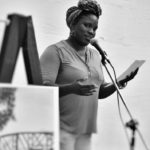 Elizabeth Ligawa is a recent graduate from Truett Theological Seminary, and the Diana R. Garland School of Social Work, earning both her Master of Divinity, and Master of Social Work. Though her prized role is being a mother to her dear son, Elijah, Liz has a love for encouraging people to come together in ways that engender healthy communities. Her role as the Director of Community Engagement at Prosper Waco allows her the room to work in and among the many faces of her beloved Waco community. She may be reached at liz@prosperwaco.org.
Elizabeth Ligawa is a recent graduate from Truett Theological Seminary, and the Diana R. Garland School of Social Work, earning both her Master of Divinity, and Master of Social Work. Though her prized role is being a mother to her dear son, Elijah, Liz has a love for encouraging people to come together in ways that engender healthy communities. Her role as the Director of Community Engagement at Prosper Waco allows her the room to work in and among the many faces of her beloved Waco community. She may be reached at liz@prosperwaco.org.
The Act Locally Waco blog publishes posts with a connection to these Aspirations for Waco. If you are interested in writing for the Act Locally Waco Blog, please email ashleyt@actlocallywaco.org for more information.
(Tami Nutall Jefferson, a married mother and grandmother, is going back to school and she has invited us all along to enjoy the ride. For more posts in this series, click here: Tami’s Big Do Over. – ABT )
By Tami Nutall Jefferson
In the middle of a conversation about nothing, I said, “Honey, I’m going to Howdy Week.” “What’s that?” While searching for an accurate description, and realizing that I didn’t know myself, It’s a week of parties!” just flew out of my mouth – and with such exuberance. The look I inspired was not a pleasant one. His response, “You can say ‘Howdy’ on Facebook.” I insisted that I must go. I knew I could seal the deal when I mentioned that I was going to the StartUp RoundUp student entrepreneur extravaganza. I don’t think his buy-in increased much. Nevertheless, welcome week — here I come!
The Backstory
There are several opportunities for students to ease into college life during the summer. The first is Fish Camp – a freshman tradition. One that I coveted as a local high schooler. But when I started receiving correspondence this year about it, I was like “just…no.” Then, there is T-Camp. Initially, I was excited about this. A camp just for transfer students – most of whom would NOT be 18 years old. I logged on to the website to find out more. Reasonably priced. Aggie Traditions. Make friends. Sign me up! Then I read the list of ‘items to bring’. The first three items listed were “pillow, pajamas, and blanket.” Wait. What the what?? This is a real damn camp!! I just closed the page. But then, you have “Howdy Week.” A chance to be a part of the Aggie community, participate in 2 hour events, AND sleep in my own bed. Perfect, I’m in!
It’s To Be Expected
I’m going to set out my expectations here. “Universe! I expect you to deliver.” Even though I’m 42 years old, I do have the same type of excitement and brand-newness that I would have had if I were 17 years old. I just don’t have the energy and heat tolerance.
- So my first expectation is that this week is going to really push me out of my comfort zone – which is everything at my fingertips in a chilled 72 degree environment.
- Half of me expects to capture my entire experience on social media – the other half of me expects that I will not want to (as I will be living in the moment).
- All of me expects to never have to pay for food and be fully stuffed on hot dogs, hamburgers, and Slovacek sausage – apparently, another Aggie tradition.
- I do expect to make at least 1 new friend (who is not a professor or employee). One of 30,000 is possible, right?
- I expect to not nap during the day. I repeat, NOT nap during the day. That’s called ‘reverse psychology’ for the non-academics in the audience.
- None of me expects to get ‘college-girl’ wasted. For some reason, that is my husband’s expectation though. Then I’ll be another college statistic. “Really, sir?”
- But in the end, I do expect to come back with at least one funny to tell you. If not, then I did not do my job as a…well…person. Every person should have at least one funny during any given week, right? And yes, I use funny as a noun, not an adjective.
Well, What Had Actually Happened Was…
So, now it’s the Monday after Howdy Week. Let’s recap, shall we. I made it to Howdy Week on Thursday. So my week, turned into a weekend. For some reason, I just couldn’t tear myself away from my exciting Waco life and my work projects to go and do basically nothing. As long as I’m there for StartUp RoundUp on Friday I’m good. And I was. And it was 6 hours of non-stop free gourmet food and million dollar business advice.
AND, I forced myself (now or never) to do the impromptu open mic business idea pitch contest – 30 seconds, no Q&A. And from that I did make 1 new friend. Later in the day, I made a few more. It was awesome! I did take several pictures, but I purposefully reminded myself not to selfie everything. But, not one Slovacek sausage! Instead of getting ‘college-girl’ wasted I got the equivalent of ‘fat-kid’ wasted. I ate so much this weekend. I don’t want to see food anymore this semester. Coincidentally, my favorite biz idea at StartUp RoundUp was from the guy who created the UniBees app that let’s you scroll through all the free food offerings on campus. Be still my tummy!
And I did get that funny. It’s in my Facebook album along with my photo ops and biz pitch video. My environmental comfort zone needed no pushing, as the weather in Bryan-College Station
was rather lovely the entire weekend. My naps were off the chart though, as all Howdy events were cancelled, and the rain makes one want to caress the bed all day.
Now, It’s Official
I am an Aggie! And a pretty strong and resilient woman. But, in the last five days, I have experienced every spectrum of emotion – loneliness, happiness, despair, hope, sadness, excitement, love, fatigue, disappointment, rejection. A lot of that from me walking around A&M alone. Experiences ranged from me being dismissed by someone who I thought was a professional colleague to imaginations of my daughter & grandson hailing a boat ride just outside of the doorstop or my sister & baby nieces sitting atop of their second story roof. I can’t begin to imagine what it’s like to be a true college freshman having to face all of these emotions this week – especially since so many of my fellow Aggies come from the coastal area. But my greatest hope now, is that we have no Silver Taps ceremonies for our current or former students. I hope that everyone is able to enjoy the belated semester start date, and I hope that as urban planning, construction, and design students we can continue those Facebook conversations we started about better infrastructure design, and building design, and stormwater management so that this weekend doesn’t happen again. God Bless Texas.
 Tami Nutall Jefferson has over a decade of experience in real estate sales and management and currently works as a home and building designer. This Fall she will begin her first academic year at Texas A&M University pursuing a Bachelor’s Degree in Urban Planning and Real Estate Development while commuting between Waco and College Station. Her hope is that Waco becomes the most attractive, modern, vibrant, and prosperous version of itself as an inclusive city and her professional mission is to help make that happen. Tami is also a 2017 graduate of the Leadership Plenty Institute and volunteers her time and voice to many downtown Waco placemaking and economic development causes and organizations.
Tami Nutall Jefferson has over a decade of experience in real estate sales and management and currently works as a home and building designer. This Fall she will begin her first academic year at Texas A&M University pursuing a Bachelor’s Degree in Urban Planning and Real Estate Development while commuting between Waco and College Station. Her hope is that Waco becomes the most attractive, modern, vibrant, and prosperous version of itself as an inclusive city and her professional mission is to help make that happen. Tami is also a 2017 graduate of the Leadership Plenty Institute and volunteers her time and voice to many downtown Waco placemaking and economic development causes and organizations.
To engage and share your non-traditional student experiences with Tami, contact her at taminutall@gmail.com or connect with her on Facebook https://m.facebook.com/tami.nutall1
By CeRon Ford
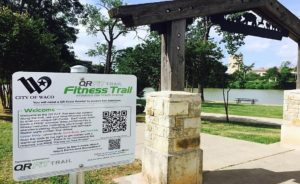 The summer climate and abundance of parks with green meadows make the City of Waco an ideal location for outdoor fitness. On a typical day, the sun is shining, the birds are chirping, and the breeze feels divine! Why confine yourself inside a gym for a workout? The QR Fitness Trail System allows you to replicate many gym exercises in the outdoors and all you need is your smartphone!
The summer climate and abundance of parks with green meadows make the City of Waco an ideal location for outdoor fitness. On a typical day, the sun is shining, the birds are chirping, and the breeze feels divine! Why confine yourself inside a gym for a workout? The QR Fitness Trail System allows you to replicate many gym exercises in the outdoors and all you need is your smartphone!
Through funding made available from the Texas Department of State Health Services and the Texas Healthy Communities grant, the Waco-McLennan County Public Health District and Live Well Waco have partnered with the City of Waco Parks and Recreation Department to have the QR FIT Trail system installed and ready to use in 11 neighborhood parks this summer. The QR Fitness Trail System will provide the perfect opportunity for community residents to lead an active lifestyle without the cost of a gym membership or fitness trainer.
The QR Fitness Trail System has been installed around walking and running trails in 11 parks throughout Waco:
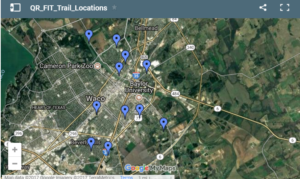 Alta Vista Park
Alta Vista Park- Bells Hill Park
- Bledsoe-Miller Park
- Brazos Park East
- Brooklyn Park
- Council Acres Park
- East Waco Park
- Gurley Park
- Kendrick Park
- Oakwood Park
- Oscar DuConge Park
The QR FIT Trail is a high tech fitness course designed for individuals of all ages. It is comprised of a series of signposts placed along the parks, and each sign post or station features Quick Response or QR codes that link a user’s smartphone to workout instructions and instructional videos. Park visitors will use the camera on their smartphones to scan the QR codes on each sign. Each workout station offers 4 workout options that focus on core, upper body, lower body and flexibility. For the users who may be intimidated by the difficulty of exercises, the fitness system provides users the option to select beginner, intermediate, or advanced. Free QR Code readers are available through smartphone app stores. Also, no additional fitness equipment is necessary in order to perform these exercises.
Alexis is a 27 year-old Waco resident who has set a goal to lose 15 pounds before her sister’s wedding in the next couple of months. Like many others, money is tight for Alexis. She does not have the funds to hire a fitness trainer or pay for a monthly gym membership. Alexis heard an ad about the QR Fitness Trail System while listening to the radio on the way to work one morning, so she decided that she would try the QR Fitness Trail System later that evening. Alexis mentioned that she briefly played volleyball in high school, but she has not dedicated much time to her physical fitness since then. However, since using the QR Fitness Trail System at her local park, Alexis has lost a total of five pounds just within a couple of weeks. When asked how effective has the QR Fit Trail System been, Alexis responded, “I think this is a great tool with a great purpose. It’s quick and easy for me to use, the trainers from the workout videos show me how to actually perform the exercise for my specific body area, and it costs me nothing!” Alexis also stated, “I would love to see more community members use this system, so I plan to invite my friends to use the QR Fitness Trail System so that they can get in shape too!”
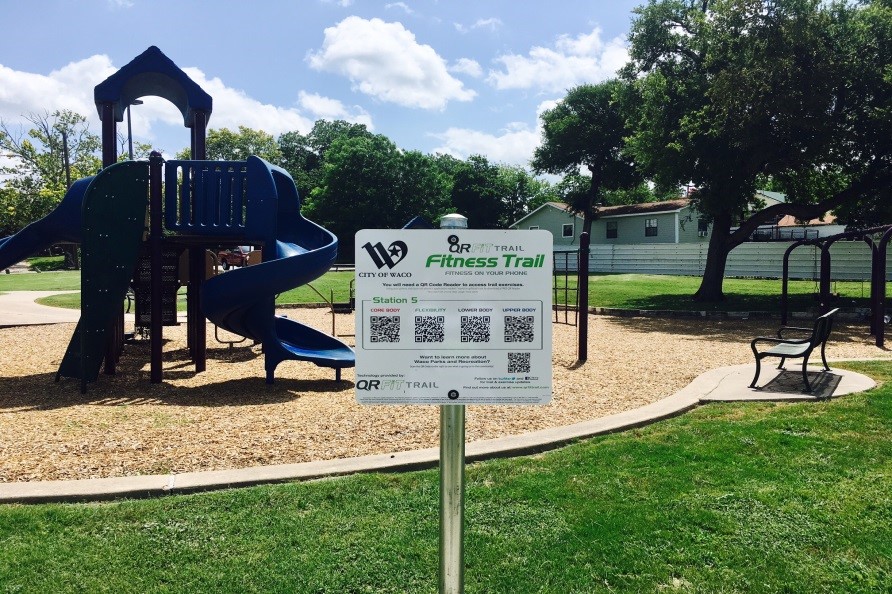
In the age of cable television, Facebook, YouTube and Instagram, it’s a great idea to travel beyond the screen or the front door and use your smartphone for something that will benefit you in the long run—like your health! There are many physical and mental benefits of exercising outdoors.
Research has proven that exercise help control and prevent the following:
- Heart disease
- Stroke
- Depression
- High blood pressure
- High cholesterol
- Type 2 diabetes
- Arthritis and much more
Studies have also shown that exercising outdoors can help people think more clearly, burn more calories, increase family time, meet your neighbors and save money. The right amount of fresh air and sunshine can be almost impossible to beat. Don’t let the summer pass you by, get to one of these local parks and get fit!
The QR Fitness Trail System is an awesome way to promote health and fitness in the City of Waco. This system is the best thing since sliced bread! The fitness system allows smartphone users to lose weight, get in shape, explore the neighborhood, experience the outdoors, and enjoy the beauty of Waco. Pick up your smartphone, grab a bottle of water, and head to one of these local parks!
Have questions about the fitness system? Want to show off how you and/or your friends and family us the QR Fitness Trail System? Share your photos and videos with us (@livewellwaco) on social media, and remember to include the hashtag #WacoQRFit.
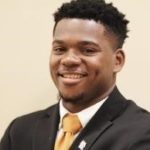 CeRon Ford moved to Waco in August 2013 to attend Baylor University. He received his Bachelors of Science in Public Health, and had the opportunity to intern at the Waco-McLennan County Public Health District as a Live Well Waco intern during his final summer in Waco. CeRon will further his efforts of pursuing public health by attending Morehouse School of Medicine’s Master of Public Health Program in Atlanta, Georgia, In the Fall 2017.
CeRon Ford moved to Waco in August 2013 to attend Baylor University. He received his Bachelors of Science in Public Health, and had the opportunity to intern at the Waco-McLennan County Public Health District as a Live Well Waco intern during his final summer in Waco. CeRon will further his efforts of pursuing public health by attending Morehouse School of Medicine’s Master of Public Health Program in Atlanta, Georgia, In the Fall 2017.
The Act Locally Waco blog publishes posts with a connection to these aspirations for Waco. If you are interested in writing for the Act Locally Waco Blog, please email ashleyt@actlocallywaco.org for more information.
Photo Credits: CeRon Ford Photography, Courtesy of Waco-McLennan County Public Health District, 2017
by Sara Beth Stoltzfus
My name is Sara Beth Stoltzfus and I am a case manager at MCH Family Outreach. At MCH Family Outreach, we provide support to families through in-home case management services, parent education and caregiver empowerment groups. Until recently, what we now call our Caregiver Empowerment Groups were only open to relative caregivers (grandparents raising grandchildren, aunts raising nieces and nephews, etc.) I have been facilitating these support groups for almost three years now and as we transition to a new schedule and more inclusive format (all caregivers of kiddos are welcome!), I wanted to reflect on why these groups are so important.
I googled the definition of support, because support is one of the key elements of the groups. Some definitions I found were “to bear all or part of the weight of; hold up,” “give approval, comfort, or encouragement to” and “to be actively interested in and concerned for the success of.”
After reading these definitions, I thought to myself, “Yes! Exactly! This is already happening in our groups.” The caregivers who attend our groups each month are absolutely giving comfort and encouragement to each other. And while no one person is holding all of the weight of another person in the group, all in the group are bearing witness to each other’s joy, struggles and the general craziness of parenthood, listening and holding the space for one another.
I am always delighted when after the hour-long group is done, I see two grandparents exchanging phone numbers to meet up. And while I am bound to confidentiality, I think it is great when a caregiver asks me how someone is doing who has not attended the group in a while. I have witnessed a true concern for the success of others in the group.
One definition of empowerment as defined by Wikipedia is “the capacity of individuals, groups and/or communities to take control of their circumstances, exercise power and achieve their own goals, and the process by which, individually and collectively, they are able to help themselves and others to maximize the quality of their lives.”
I love this definition. When caregivers of children get together to support one another, ultimately the goal is to maximize the quality of their own lives and their children’s lives, individually and collectively. Increasing a caregiver’s power and more importantly, knowledge of their power, is key. A mother who thought she was failing in so many ways will realize that there are plenty of moms who think they are failing too. A grandmother who thought there was no hope for her child with sensory needs realizes there are many other grandmothers with similar kiddos and that there are resources out there for her grandchild. With this new knowledge, she will realize, I CAN do this. I am able to support my child.
In a very independent society, caregivers need support as they also need to support others. Caregivers need a place for vulnerability and tears as well as joy and laughter. Through this mutual support, we hope that caregivers will be empowered, becoming stronger and more confident, in control of their lives.
Our hope is that they would know their own power to create beautiful, connected, empowered children.
We invite anyone caring for a child to come to a Caregiver Empowerment Group. Every new voice in the group is impactful and your story can empower another caregiver.
Caregiver Empowerment Groups will be held on the 2nd Tuesday of September, October and November, one group in the morning from 11am-12pm and one in the evening from 6pm-7pm. The groups will be located at MCH Family Outreach at 1111 Herring Avenue Waco, Texas 76708. Call 254-750-1263 for more information!
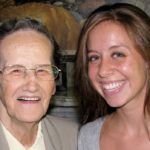 This Act Locally Waco blog post was written by Sara Beth Stoltzfus. Sara Beth is a Social Worker at MCH Family Outreach through the Methodist Children’s Home. Sara Beth is originally from Pennsylvania but has been living in Texas for more than 6 years, 4 of which have been spent in Waco. Sara Beth enjoys spending time with her husband, James, and dog, Bud, as well as with her church community, Hope Fellowship. Sara Beth also enjoys participating in social justice work with other Wacoans.
This Act Locally Waco blog post was written by Sara Beth Stoltzfus. Sara Beth is a Social Worker at MCH Family Outreach through the Methodist Children’s Home. Sara Beth is originally from Pennsylvania but has been living in Texas for more than 6 years, 4 of which have been spent in Waco. Sara Beth enjoys spending time with her husband, James, and dog, Bud, as well as with her church community, Hope Fellowship. Sara Beth also enjoys participating in social justice work with other Wacoans.
The Act Locally Waco blog publishes posts with a connection to these aspirations for Waco. If you are interested in writing for the Act Locally Waco Blog, please email ashleyt@actlocallywaco.org for more information.
By Peaches Henry
To be clear, this is not a Right or Left, Republican or Democratic, North or South, or Black or White issue. This is a matter of right or wrong. We are confronted with a life and death moral dilemma. We must decide whether to take a stand against those who advocate racism, anti-Semitism, and xenophobia. A united body of Blacks, whites, Christians, Jews, Muslims, Democrats, Republicans, and like-minded individuals willing to reject purveyors of hate will defeat their attempt to take this country back to a very dark place.
We must publicly denounce these attitudes and behavior. To remain silent is to condone it. To equivocate is to give it cover. This must not be the message of our nation or of our leaders.
The Waco NAACP condemns the blatant, heinous acts of hate groups and so too should those who respect our country’s most treasured values. To many African-Americans, Jews, and others, the images of armed Ku Klux Klanners, white nationalists, and neo-Nazis marching in Charlottesville seemed like a horrific nightmare that recalled decades of intimidation, violence, and murder. Tragically, those scenes were all too real as these groups gathered in a so-called Unite the Right rally to “take America back.” In 2017, carrying guns, knives, and other weapons, the KKK marched on Charlottesville. White supremacists with torches surrounded a church filled with African-American ministers and their allies. Intending to evoke the 1930s Hitler Youth marches, Neo-Nazis conducted a torchlit parade through the campus of the University of Virginia shouting Nazi slogans: “Blood and soil!” “You will not replace us!” “Jews will not replace us!” Minus the hoods of the twentieth century, these mostly white young men instead proudly exposed their faces and wore white polo shirts and khaki pants. Former KKK leader David Duke and white nationalist leader Richard Spencer were conspicuously present at the events.
The intimidation of the parade and march was followed up the next day by actual violence. White supremacists savagely beat African-American Deandre Harris in a parking lot. Two state troopers, who were monitoring the event from a helicopter, crashed and died. The KKK, white nationalists, and neo-Nazis armed with shields and wooden clubs charged and attacked a group of counter-protestors. The protestors fought back. Ultimately, a white nationalist (allegedly) deliberately drove his car into a crowd of counter-protestors killing Heather Heyer and wounding 19 others.
The president’s repeated refusal to unequivocally condemn these hate groups demonstrably serves to embolden them. The president must be called out for failing to show moral leadership. To do so is not a partisan tactic. It is simply right. Casting blame on the counter-protestors, who chose to defend themselves, is reminiscent of charges brought against civil rights marchers in the 1960s who were called violent when they were attacked by white citizens, law enforcement, and the KKK. The president must not give quarter to the KKK, white supremacists, and neo-Nazis through ambiguous rhetoric or false moral equivalency. African-Americans, indeed all Americans, need the president to unreservedly side with us against the purveyors of hate. Period.
We must all stand together against those who are uniting for hate. Make no mistake. Richard Spencer and his cohorts will not stop with Charlottesville. While Texas A & M has prevented a rally “inspired by [Charlottesville’s] “Unite the Right” event, that will probably be a temporary situation. The hate groups are coming.
The racist damage at Willow Grove Baptist Church demonstrates that they are already among us. Those who would minimize the incident at Willow Grove as teenaged vandalism, misjudge the case. If the damage was perpetrated by teenagers, that is both tragic and dangerous. Tragic, because it means young people have imbibed racist, bigoted ideas. Dangerous, because youth can be violently impulsive. We must engage our youth and teach them that the KKK terrorized and lynched African-Americans and burned their churches for decades. We must teach them that the Nazis exterminated homosexuals, the intellectually disabled, gypsies, and six million Jews. And we must love them, because love transforms and redeems. However, to reclaim these young people we must recognize that evil is among us.
My own personal experience proves that hate groups are already here. On Sunday July 16, while sitting in church, I started to open the Bible app on my phone and was inundated with racist text messages calling me “nigger,” likening me to images of monkeys, declaring that the texter had “the power to keep niggers down,” and referring to the “NAAC Pee Pee.” [And no, I will not use the “n-word.” The writer of those texts did not call me the “n-word.” He repeatedly called me “nigger.”]
This moment in our country requires us to face hard truths about our racial history. For instance, we must face the fact that most of the Civil War statues and memorials around this country were erected with the express purpose of re-asserting white supremacy over African-Americans after Reconstruction, during the Jim Crow era, and after the Civil Rights Movement. Some may argue that they were erected to recognize our history. Yes, the Civil War is a part of our history. It is the history of people who left the United States and waged war against it in order to keep Black people enslaved. That objective was written into the constitution of the Confederacy. Some may argue that the Civil War was fought over states’ rights. States’ rights to do what: to enslave Black people. The Nazi era is a part of Germany’s history. You do not see statues of Hitler sprinkled around that country. Whether these statues remain, come down, or are removed to museums, they represent a flashpoint of conscience which this country must confront. The purveyors of hate have made their position clear. The rest of us must decide which side of history we are on.
The Waco NAACP will continue to be steadfast and immovable in the fight against discrimination, prejudice and hatred. The Waco NAACP is prepared to meet, march, and hold rallies that counter the racist, white supremacists ideologies that these groups espouse. The Waco NAACP will persist until we drive out racism and racist actions. We will accept all people of good will who are willing to stand with us. And we are not afraid.
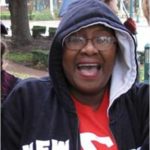 Dr. Peaches Henry is a graduate of the University of Texas. She received both her master’s and doctorate in English from Columbia University in New York. She is an English Professor at McLennan County Community College. She is the current president of the Waco McLennan County branch of the NAACP. Join and support the NAACP with your dollars and your resources: waconaacp.org.
Dr. Peaches Henry is a graduate of the University of Texas. She received both her master’s and doctorate in English from Columbia University in New York. She is an English Professor at McLennan County Community College. She is the current president of the Waco McLennan County branch of the NAACP. Join and support the NAACP with your dollars and your resources: waconaacp.org.
By Sarah Miller
When people hear that I’m a hospice chaplain, they often say “OH that sounds so hard!” or they immediately tell me their death story. Most people have a story about someone in their life who has passed away. After telling me their story, they thank me for listening and for being curious about their loss. People LOVE to share their experience.
Our culture prefers to talk about newborn babies and new life but not so much about end of life care and death. I lecture on death and dying at Baylor University and have noticed that even college students have often been connected to someone who has died or have walked with a friend who has lost a loved one. I think it is important for stories to be heard.
Since getting people to talk about death before a crisis happens is one of my interests, I decided to offer two events to the Waco community this summer. In May, I hosted a Death Café at the Good Neighbor House. Death Café was starting in England by a man named Jon Underwood. He wanted to create a space where people, often strangers, would get together to drink tea, eat cake, and discuss death. The objective of Death Café is “to increase awareness of death with a view to helping others make the most of their finite lives.” I wasn’t quite sure what to expect when I invited anyone interested to show up, eat cake, and talk about death with me. I was delighted by this gathering of kind, curious Wacoans who arrived ready to talk about all things death. A death positive Waco facebook group was created after this event and has sparked some great conversations.
In August, another chaplain and I hosted a Death Over Dinner (again at the Good Neighbor House). The concept is quite incredible. Guests meet for dinner and talk about end of life issues. The organization recommends listening, reading, and watching various stories or articles before the dinner and offers questions to guide the evening. I enjoyed getting to hear from people from a variety of backgrounds and hear what is meaningful to them. More death related events will be planned in the upcoming months. I would love for more Wacoans to tell their stories and also to ask questions and process death topics in safe spaces.
Due to the nature of my job, I’m asked the same questions over and over so thought the blog readers might have interest in my answers. The most popular question is this: How can you work with dying people and grieving families and not get burned out? Compassion fatigue is a real thing! I do a few things to prevent burn out. I do at least 3-4 yoga classes per week. Making my body and breath work together in a yoga class helps tremendously with stress relief. I also spend time with my husband, adorable son, and lots of friends. I’m an extrovert so need to have intentional, fun space with people who are life-giving to me. I also journal after a hard day and use my coworkers to process grief when a favorite patient dies or if I’m feeling particularly sad. Another question I get asked often is what books or websites do I recommend. I think everyone should read Being Mortal by Dr. Atul Gawande and When Breath Becomes Air by Dr. Paul Kalanithi. The websites I use frequently are: www.theconversationproject.org, www.agingwithdignity.org, www.caringinfo.org, www.compassionandchoices.org, www.griefshare.org.
Talking about death and end of life care can be a little scary initially but I recommend families and friends do this when possible. It is much better to know in advance what your loved ones want. If anyone wants more information on upcoming death-related events, please go to Death Positive Waco on Facebook.
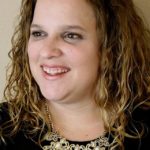 Sarah Miller has lived in Waco for the past fifteen years and is a chaplain with SouthernCare Hospice. She loves encouraging patients and families at the end of life. She can be found most nights doing yoga at the Yoga Pod or hanging out with her husband and delightful five year old.
Sarah Miller has lived in Waco for the past fifteen years and is a chaplain with SouthernCare Hospice. She loves encouraging patients and families at the end of life. She can be found most nights doing yoga at the Yoga Pod or hanging out with her husband and delightful five year old.
By Emily Carolin
This fall, the Mayborn Museum at Baylor University will host the exhibition, Find a Way, Not an Excuse: Women in STEM. Focused on the lives of 19 women and their contributions to science, technology, engineering, and math fields, the exhibit also includes women with local connections. This project would not have been possible without the initial idea and input of Courtney Berge and Valencia Johnson, recent alumnae of the Baylor University Museum Studies Graduate Program.
What is STEM?
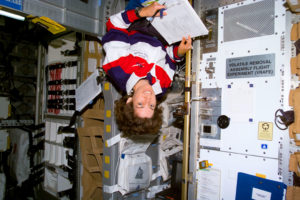
Ellen Ochoa, Astronaut
STEM is shorthand for Science, Technology, Engineering, and Math. These sectors work together to expand human knowledge and make the world a better place. Women have contributed in STEM fields for generations, often without credit. Some female leaders were discouraged by fellow scientists, and pushed out of research projects. Even without the recognition, their accomplishments live on today. This exhibit highlights some unfamiliar women who changed the world.
As we focus on pioneering innovations in STEM, we hope to inspire a fierce desire to learn continuously, and through perseverance allow curiosity to lead to discovery. We celebrate these female STEM leaders and are excited by all that remains to be discovered.
Here are a few female pioneers with a Baylor connection. Come to the museum to see more national names and some amazing medical drawings by Ruth Sanders!
Dr. Cornelia Marschall Smith
In 1895, Cornelia Marschall was born into a family well-versed in the practice of the sciences. She graduated from high school in three years, taught in a one-room schoolhouse, and entered the Baylor pre-medical program in 1915. Dr. Smith came back to Baylor, serving as Chair of Biology and Director of the Strecker Museum (now the Mayborn Museum Complex) from 1943-1967. While at the Strecker, her primary objective as museum director was to make sure the materials in the museum were used as teaching tools. Students in the biology department were required to attend demonstrations in the museum, and teachers used items from the collection in their classrooms. These practices continue today at the Mayborn.
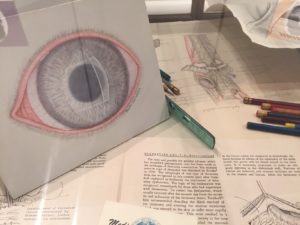 Ruth Maxwell Sanders
Ruth Maxwell Sanders
Ruth Sanders was a skilled medical sketch artist and wife of Strecker Museum Research Associate and herpetologist Ottys Sanders. She assisted as the illustrator for many of her husband’s publications, and maintained a successful business herself. In her position at Southwestern Medical College (UT Southwestern), she worked with physicians to produce high-quality surgical illustrations. This allowed the physicians to teach precise methods to their students. Her collection of medical drawings and art supplies were given to the Strecker Museum and show a strong understanding of the human body.
Dr. Allene Rosalind Jeanes
If you enjoy ice cream, salad dressing, toothpaste, or gluten-free baked goods, then you probably owe a word of thanks to this Baylor alumna who was recently inducted into the National Inventors Hall of Fame. Jeanes made discoveries in the science of mass production of polysaccharides (large sugar-chain molecules), including dextran and xanthan gum. Today, xanthum gum is commonly used in foods like ice cream, condiments and gluten-free breads, and in cosmetic, automotive, and healthcare products. It keeps substances like oil and vinegar 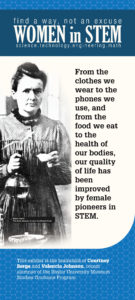 from separating, and prevents ice crystals from forming.
from separating, and prevents ice crystals from forming.
Dr. Beverly Griffin
Earlier this year, Beverly Griffin passed away and medical and research communities around the world mourned her loss. She came to Baylor from her hometown of Delhi, Louisiana, and after graduating with her degree in chemistry, she went on to earn doctoral degrees from Virginia and Cambridge. In 1972, Dr. Griffin joined the Imperial Cancer Research Fund Laboratories in London. While there, she made a major contribution to science by completing the genetic sequencing of the mouse polyoma virus. With 5,293 base pairs, the virus was one of the longest ever sequenced when she finished it in 1980. She went on to become the first female professor at the Royal Postgraduate Medical School at London’s Hammersmith Hospital, where she dedicated much of the remainder of her career to studying the Epstein-Barr virus.
Dr. Hallie Earle
As a teen, Hallie Earle tracked Central Texas temperatures for decades. Baylor President Oscar H. Cooper praised Hallie for her mathematical abilities, suggesting that she could become a math teacher. Earle, however, sought to challenge gender roles by pursuing a professional career in medicine. Her quality of work was so widely appreciated that a copy of her thesis was placed in the cornerstone of the Carroll Science Building in 1902. Born in 1880, Earle was the only female in the class of 1907 at Baylor University Medical School in Dallas, and later became Waco’s first female physician.
 Emily Carolin is a Yankee living the grad school life in the South. She can often be found: devouring books and baked goods, wearing clogs, and wandering in museums. Emily is a graduate student at Baylor University, works at the Mayborn Museum Complex, and just completed her an internship in changing exhibits at the Mayborn.
Emily Carolin is a Yankee living the grad school life in the South. She can often be found: devouring books and baked goods, wearing clogs, and wandering in museums. Emily is a graduate student at Baylor University, works at the Mayborn Museum Complex, and just completed her an internship in changing exhibits at the Mayborn.
The Act Locally Waco blog publishes posts with a connection to these aspirations for Waco. If you are interested in writing for the Act Locally Waco Blog, please email ashleyt@actlocallywaco.org for more information.
(During December we will be reprising some of “2017’s greatest hits” from the Act Locally Waco blog. I couldn’t possibly pick my favorites – so I used the simple (cop out?) approach of pulling up the 10 blog posts that got the most “opens” according to our Google Analytics. It is an intriguing collection that gives at least a little insight into the interests and concerns of Act Locally Waco readers. I hope this “Top 10” idea inspires you to go back and re-read your personal favorites. There have been so many terrific ones… If you would like to see the Top 10 according to Google Analytics, here’s the link: 2017 Greatest Hits. Merry Christmas! — ABT)
By Kassidy Munden
After my first year of college, I began to realize there were things I really (and I mean really) wish I had known in high school to help make my transition to college smoother.
The first thing I would advise any high schooler would be to take the high school anatomy class. I didn’t think I would ever need anatomy in my future profession, or even have to take it in college, but I could not have been more wrong about that. High school students considering going to college should seriously consider taking an anatomy class. My biggest regret about not taking anatomy in high school was that when I got to college, I was far behind my classmates and didn’t know a single thing. You can imagine how well a 100-question test over blood flow in the body went for me three weeks into my freshman year.
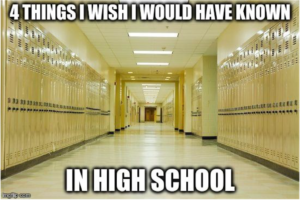 The second thing I would recommend for any high schooler would be to take dual credit in high school. Looking back on high school, that had to be one of the best educational decisions I made to prepare for college. Thanks to dual credit, I had all of my core English classes completed by the time I began college. Not only was it one less major class I had to take, I also learned how to properly write college papers. This helped me in my other classes as well, because in every class, even math, I had to write some type of proper essay. Knowing how to format and write these essays before my freshman year paid off in a huge way. I wish I had known to take more of the dual credit classes my high school offered, because even though they seemed difficult, they were more rewarding in the long run than they seemed at the time.
The second thing I would recommend for any high schooler would be to take dual credit in high school. Looking back on high school, that had to be one of the best educational decisions I made to prepare for college. Thanks to dual credit, I had all of my core English classes completed by the time I began college. Not only was it one less major class I had to take, I also learned how to properly write college papers. This helped me in my other classes as well, because in every class, even math, I had to write some type of proper essay. Knowing how to format and write these essays before my freshman year paid off in a huge way. I wish I had known to take more of the dual credit classes my high school offered, because even though they seemed difficult, they were more rewarding in the long run than they seemed at the time.
The third thing I wish I had known was to take the college transition class offered. Most high schools offer a college transition class and extend the class to all seniors. I did take this class, but I wish I had taken it more seriously. This class teaches students about life in college and how to live on your own, as well as educational enhancements such as how to build a resume. Looking back now, I wish I had learned how to build a proper resume, because that is something I will need for anything and everything. Most freshmen take classes requiring them to build a resume of some sort, and trust me, learning about it in detail in high school is easier than trying to learn it on your own in college.
The fourth and final thing I wish I had known was to get a job or internship. Most high school students declare their major “undecided” when entering their freshman year of college, which is completely normal. However, I wish I had explored more job opportunities and taken internships. These not only look great on a resume but also help you develop an idea of what you might actually want to get a degree in. Having more of a background in several different positions makes you a more diverse and knowledgeable individual. Did I mention it also will give you a stronger resume when you apply for college? That is key for all aspiring college students.
High school is a profound experience-building time for everyone, and I highly recommend that college-bound students seek out all of the opportunities available, because they definitely will pay off in the long run.
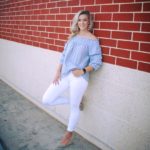 Kassidy Munden is a summer intern at ESC Region 12 in the College and Career Readiness/CTE department. She is a student at Texas Tech University and wanted to share her wisdom with current high school students.
Kassidy Munden is a summer intern at ESC Region 12 in the College and Career Readiness/CTE department. She is a student at Texas Tech University and wanted to share her wisdom with current high school students.
By Ashley Bean Thornton
A few weeks ago I attended a welcome and “get to know you” reception for our new Waco ISD Superintendent, Dr. Marcus Nelson. The event, sponsored by the Waco NAACP and the local chapter of educator sorority, Phi Delta Kappa Inc., was a terrific success. Dr. Peaches Henry, NAACP president, told me they had put out 50 chairs before the event – by the time Dr. Nelson rose to speak they needed 200. Dr. Nelson made some fans for himself that night. His introductory speech was masterful: full of humor, passion, challenge and confidence. His speech wasn’t exactly a sermon, but there were plenty “amens” from the congregation as he shared key elements of his educational philosophy.
A few days later I happened to be walking out of a different meeting with school board member Norman Manning. I told him I thought they might have hit a homerun with Dr. Nelson, and Mr. Manning agreed. As we were talking, though, he mentioned some other conversations he has had about our new superintendent. He told me several people had been asking, “Well, if he’s so great — why does he want to come HERE?”
Why here? I don’t know Dr. Nelson yet, and I can’t read his mind, but I can think of at least three big reasons why a superb educational leader in the prime of his career would want to come to Waco, Texas.
First, if you believe in the power of education, Waco is exactly where you want to be. Sure, there are probably easier places to work. But, for someone who believes in the power of education, that’s not where the action is. There are school systems with more money. There are schools where the students have more advantages. There are probably even some schools where, honestly, the students are going to be fine if you are even a moderately competent educator. But, where’s the sport in that? The purpose of public education is not to perpetuate the status quo. The purpose of public education is to perpetuate the dream – the dream that a person, any person, starting from any circumstances, can work hard and achieve and build a good life. Waco is a place where “the rubber meets the road” when it comes to that dream. Waco is a place where educators make a huge difference in students’ lives every day.
Second, there is plenty to build on in Waco. I’m an outside observer, I know, but I have some favorites: The Income Tax Prep program at the A.J. Moore Academy at University High; The Greater Waco Advanced Manufacturing Academy (GWAMA), the Greater Waco Health Career Academy (GWACHA) and the new Construction Sciences Academy; the fine arts programs including the amazing musicals; our support for homeless students…the list goes on. We have terrific students at WISD. When they are given the opportunity, they can knock your socks off. We also have some terrific educators who are working and innovating every day to give them those opportunities.
Finally, the community of Waco needs a strong school district and we know it. I get phone calls and emails regularly from people who are moving to Waco and want the “inside scoop” on living here. I have not had one of these conversations yet that did not end up being a conversation about school districts. These conversations reinforce for me what we all already know: Any community that expects to thrive must have a strong school district…and Waco expects to thrive. Our community has shown it is willing to join in the work of building up the school district. Through community-wide efforts such as the Education Alliance (now a part of Prosper Waco) we have been rallying support for years. Organizations such as Avance and Communities in Schools, tutoring programs sponsored by a variety of churches and community groups and numerous individual volunteers stand ready to help.
In 2015 our community showed its support for WISD by passing a Tax Ratification to direct new financial resources into the district – resources that have been used to improve literacy programs; to explore and implement positive, effective ways to work on behavioral issues; and to provide outstanding dual credit opportunities to WISD students.
Certainly, Waco ISD has its challenges. We also have the wisdom and the will to face those challenges head on. By all accounts, Dr. Nelson did his homework before accepting the job as superintendent of our school district. I think he saw a terrific opportunity in Waco, and was smart to jump on it.
For the first day of school the Waco NAACP organized a group of us to “greet the scholars” at J. H. Hines Elementary. As we welcomed the children back to school and wished them a wonderful school year, Dr. Nelson showed up to do the same. I had the honor of introducing him to Pastor Pam Rivera of St. Luke A.M.E. Church. She welcomed him warmly to Waco, and as he acknowledged the welcome he lowered his voice a bit to say seriously, “We have a lot of work to do.” She didn’t hesitate in her response, “and plenty of people who want to help.” Amen, Pastor Rivera!
Welcome to Waco, Dr. Nelson. Hard work pays off!
 This Act Locally Waco blog post is by Ashley Bean Thornton, she has lived in Waco almost 20 years now. Far longer than she ever lived anywhere else. She likes to walk. If you see her out walking, honk and wave and say “hi!”
This Act Locally Waco blog post is by Ashley Bean Thornton, she has lived in Waco almost 20 years now. Far longer than she ever lived anywhere else. She likes to walk. If you see her out walking, honk and wave and say “hi!”
The Act Locally Waco blog publishes posts with a connection to these aspirations for Waco. If you are interested in writing for the Act Locally Waco Blog, please email ashleyt@actlocallywaco.org for more information.
(During December we will be reprising some of “2017’s greatest hits” from the Act Locally Waco blog. I couldn’t possibly pick my favorites – so I used the simple (cop out?) approach of pulling up the 10 blog posts that got the most “opens” according to our Google Analytics. It is an intriguing collection that gives at least a little insight into the interests and concerns of Act Locally Waco readers. I hope this “Top 10” idea inspires you to go back and re-read your personal favorites. There have been so many terrific ones… If you would like to see the Top 10 according to Google Analytics, here’s the link: 2017 Greatest Hits. Merry Christmas! — ABT)
By Andre’ Watkins
Growing up in Waco, Texas, gives you a certain kind of insight. Waco is a mid-sized community that allows its citizens the distinct opportunity to experience all of the levels of socioeconomic strata with ease. Just take a ride down Colcord Ave. You will see the homes of the very affluent and the homes of the desolately hopeless on the same block. This is my Waco.
This Waco has a long history. During the 60’s and 70’s, Waco participated in a federal program called “Urban Renewal” meant to improve blighted areas of town. Under this program (called “Urban Removal” by those who questioned its value) entire family units were removed from neighborhoods where they had built and maintained homes and raised families. Those who remained were expected to pull themselves up by their proverbial bootstraps, which proved to be a difficult task.
Around the mid-eighties, crack cocaine ripped through my beloved city on a euphoric rampage. Crack took from the rich and poor alike. This gruesome drug fueled demon was never a black or white problem. It was a drug addiction problem.
Crack cocaine changed the landscape of Waco. Middle-class families fled to the suburbs. Neighborhood stores closed. Restaurants and grocery retailers were boarded up. This left a power vacuum in the inner city of Waco that attracted crime and despair.
A chasm opened up between the people who left and the often impoverished people who remained. Waco ISD finds itself in the position of needing to bridge this chasm. To bridge this chasm we have to be honest with ourselves: very often there is a serious disconnect between the community we serve as a school district and the service providers that work in our schools.
To address this situation we have to deal with some hard questions: How do we expect people to model their behavior after the behavior of those who left them to languish in lack? Why should I as an impoverished person seek to exemplify a lifestyle of a person or people who won’t even come to my neighborhood? Do you really care about me? Or am I a charity case or pet project?
Realizing this disconnect, we knew that we had to switch up the flow. To combat this monster of our own creation, we began to search for methods that other school districts were utilizing successfully.
Restorative Discipline just seemed to jump off of the pages of training manuals and speak directly to the heart of our issues here in Waco ISD.
To quote from the website of Life Anew, a non-profit in Austin that brings restorative practices into local community schools, “Restorative processes create a space where students and adults can develop empathy, respect and common values by listening and learning from one another. This process helps to increase the effectiveness of instruction time, build community and develop students socially and emotionally.”
At the heart of Restorative Discipline Practices, we find a tradition as ancient as the campfire circles of old, the Intentional Conversation. Intentional Conversations are simply focused discussions that seek to determine the root cause of an exhibited behavior.
We acknowledge the truth in the statement made by Sherwynn Patton, Executive Director of Life Anew, “Adverse behavior is just the smoke; when we find the reasons for the behavior, we locate the source, the fire.” We had been spending too much time putting the waters of our logic and education on the smoke. We never dug deep enough with our conversation skills and listening hearts to determine the location of the fires in our precious students’ souls.
As we began to have Intentional Conversations together as staff at Waco High, we began to seek and find our similarities as PEOPLE and to break down our cultural bias. We then began to spread this infection of emotional affection for the staff through the students into our community. Waco High dropped its rate of suspension by 46% in two years of Restorative Practices implementation. I don’t care who you are or where you are from – That is impressive! We celebrate and invite our community at large to join us in repairing harm and establishing community unity.
 Andre’ E. Watkins is a Restorative Discipline Facilitator at Waco High School. He has 16 years of experience working with at risk youth and their families including serving as Detention Supervisor at Bill Logue Juvenile Justice Center and a Training Officer at McLennan County Challenge Academy. He was a Dorm Supervisor at TYC Mart, and is the only person in the State of Texas to be promoted from JCO 1 to JCO 5 in 30 days. He volunteers at the Doris Miller YMCA, as a Prosper Waco Community Engagement Committee Member and as a Football and Basketball Coach for the Waco Eagles. He is also a Park Ranger for the City of Waco.
Andre’ E. Watkins is a Restorative Discipline Facilitator at Waco High School. He has 16 years of experience working with at risk youth and their families including serving as Detention Supervisor at Bill Logue Juvenile Justice Center and a Training Officer at McLennan County Challenge Academy. He was a Dorm Supervisor at TYC Mart, and is the only person in the State of Texas to be promoted from JCO 1 to JCO 5 in 30 days. He volunteers at the Doris Miller YMCA, as a Prosper Waco Community Engagement Committee Member and as a Football and Basketball Coach for the Waco Eagles. He is also a Park Ranger for the City of Waco.
The Act Locally Waco blog publishes posts with a connection to these aspirations for Waco. If you are interested in writing for the Act Locally Waco Blog, please email ashleyt@actlocallywaco.org for more information.
